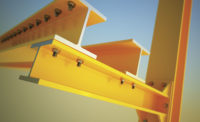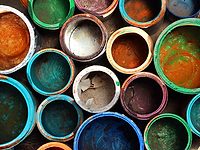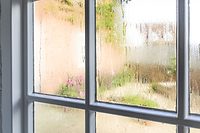How Can the Weather Impact Your Powder Coat?

People often choose powder coating for its durability, but that doesn’t mean it remains resilient against all types of weather. Here are some crucial considerations about the weather and its potential impact on the powder-coated finish.
Selecting a FEVE Formula Increases Weatherability
Selecting the right powder coating formula is a crucial step in improving weatherability. Research indicates that fluoroethylene vinyl ether (FEVE) resin-based powder coatings have more weather-resistance than traditional ones.
More specifically, metallic FEVE/polyester coatings showed enhanced weatherability due to a stratified FEVE top layer. The data also showed that such formulations were cost-effective choices due to their 70% polyester makeup.
However, researchers cautioned that some ingredient specifications are necessary to achieve the stratification structure. For example, the polyester must have a solubility parameter substantially different from the FEVE powder-grade solubility parameter of 9.1.
Additionally, many manufacturers of powder coating products offer specific extra-durable options to improve weatherability. Even if people don’t choose FEVE coatings, selecting something designed to withstand the elements will provide optimal results.
Certain Weather Makes Corrosion Happen Faster
Corrosion is an ongoing concern for items made of metal, and certain types of weather can accelerate it. For example, rust is more common in humid, wet environments than in drier climates. Similarly, corrosion typically occurs faster in warmer temperatures than colder ones.
However, winter can bring a complication, too. The salt used to de-ice surfaces makes corrosion more prevalent.
Fortunately, powder coatings are corrosion resistant, particularly when well maintained. People using this process in coastal environments have a few options that are especially durable against salt. These include a zinc-rich primer, epoxy intermediate or polyurethane coating applied to galvanized steel.
Each Step in the Powder Coating Process Affects Weatherability
A successful powder-coating application requires following all the necessary steps and not cutting corners. That’s especially true when applying it to outdoor structures. Start by cleaning the material to prepare it for the process. Ensure it is free from dirt, oily substances or anything else detrimental to the powder
It’s also crucial to select the best primer and color topcoat. When working with a blasted material, a powder primer with zinc protects against moisture penetration and safeguards against corrosion to a degree.
Powder coats keep their color longer than liquid paint. That’s why they’re a good choice for items that may stay outdoors a lot, such as deck furniture. Topcoats with polyester, acrylic or fluoropolymer are ideal for providing sunlight protection.
People must also take care to achieve the minimum film build on the surface when applying each coating. Doing this is a proactive way to protect against weather over an extended period. When it’s time to cure the material, individuals should follow manufacturer recommendations for optimal results.
Moving completed items to their intended places with care helps avoid damaging the freshly coated surfaces. Dragging a piece across hard ground or abrasives, such as cardboard, could harm it. Following all the steps is essential so the outcome is as the customer expects, and provides the necessary durability against weather and long-term use.
Real-World Tests Set Expectations for Outdoor Powder Coats
While selecting a powder coat, you may see options categorized as “outdoor durable.” That might sound like just what you need if the weather is a concern. The trouble is that you cannot select a product from that category and assume it will definitely meet your requirements. The first thing to know is that people test outdoor-durable paints in locations known for a high degree of ultraviolet exposure. In the United States, that often means South Florida and sometimes Arizona.
Entry-level outdoor-durable powder coatings keep their color and gloss for 12-18 months after the application. After that, they fade and are up to 50% less glossy. Rich and dark shades are the most likely to show such changes in appearance, and you’ll likely see that they begin to turn chalky white. Choose these lowest-grade coatings for items that only get occasional, short-term sunlight exposure, where users don’t expect a maintained appearance for more than a few outdoor seasons.
Conversely, people may choose high-performance outdoor-durable coatings. They retain their appearance for up to five years in environments similar to South Floridian conditions. High-performance powder coatings feature inorganic mixed-metal oxide or automotive-grade organic pigments to ensure the appearance stays consistent through the years.
When planning a powder coating application on car parts that are exposed to the weather, you need a product with multilayered composition, including a base coat, topcoat and clear coat. Marketers sometimes define them as hyper-durable options, and they last for at least a decade. Besides their weather resilience, these products also withstand air pollution.
Humidity Matters During Application and Storage
Powder coating materials are hygroscopic, meaning they will naturally absorb moisture. When applying powder coating in an environment with excessive humidity, you may have difficulty creating its initial electrostatic charge and maintaining it while adhering the material to the surface. Moreover, relative humidity of 45% or above significantly increases corrosion and condensation risks.
If moisture becomes trapped on the powder-coated surface during an application, it can negatively affect adherence. Moreover, as the powder absorbs moisture, it agglomerates, affecting how it flows from the powder coating gun.
Fortunately, there are several ways to mitigate problems associated with high humidity. For example, consider planning powder coating projects during the less-humid parts of the day, such as the early morning and late afternoon hours. Another possibility is to use dehumidifiers in the shop environment for humidity control.
A common solution outside of these tips is to preheat parts to 150-175 °F before coating them. Start the coating process as soon as possible after reaching that temperature range to reduce the possible unwanted effects of humidity.
Humidity remains a consideration during storage, too. You can generally keep powder coating products at less than 80 °F and in an approximate 50%-60% relative humidity range and keep it safely for at least a year. However, avoid storing it near any heat sources. Additionally, be aware that coatings with special properties related to appearance, curing or performance may require different storage conditions. You should follow the manufacturer’s instructions in those cases.
Let the Weather Influence Your Powder Coating Process
These examples show how the weather can substantially impact which coating to choose and when to apply it. Moreover, people responsible for selecting the material and moving ahead with the application must consider how long users expect the coating to retain its appearance. That factor affects whether it is necessary and worthwhile to go with an outdoor-durable coating. Some types are more expensive, but they could help meet expectations when customers want the treated surface to look great for several years.
Weighing aspects like those covered here will help people enjoy the most success when applying powder coating. Moreover, they will have accurate perceptions of how long it should last under specific weather conditions.
Looking for a reprint of this article?
From high-res PDFs to custom plaques, order your copy today!








